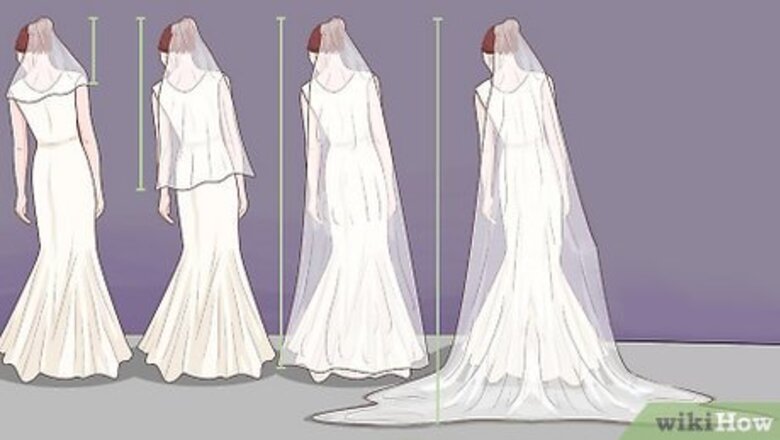
views
Making a Classic Wedding Veil
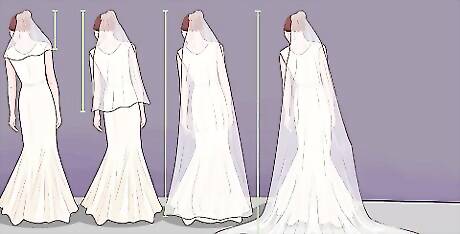
Decide how long you want the veil to be. Have a friend or helper measure down from the top of your head down to where you want the veil to end. A typical veil would come down to your fingertips, but other popular lengths include shoulder, elbow, floor, chapel, and cathedral. Your veil should drape without showing any skin at the sides of your face.
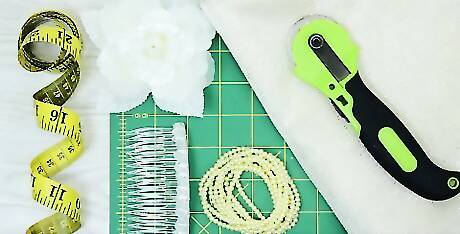
Purchase the tulle. Look for something that is around 72 inches (182.88 centimeters) wide. If you are making a shorter veil (ie: shoulder length), consider getting something that is around 55 inches (139.7 centimeters) wide. If you are making a really long veil (ie: floor or chapel), consider getting 108-inch (274.32-centimeter) wide tulle instead. This way, it will be more proportionate.
Cut the bottom of your veil into a rounded rectangle, if desired. You can leave your veil rectangular, but a rounded bottom will give you a nicer shape. Lay your tulle out with the bottom edge facing you. Fold the tulle in half, then cut the bottom (loose) corners off so that they are rounded. Your veil may look a lot wider than it is long at this point, but that is alright. Use a rotary cutter to cut your tulle—not hand scissors. That will help eliminate the chance that the edges will appear choppy. If you're making a blusher veil, cut it in a circle.v
Consider adding some trim to the rounded edge. You don't really have to do this, but since it is your special day, why not go full-out and make yourself feel like a princess? You can hand-sew a beaded trim for something more delicate. You can also sew some narrow, white, satin ribbon instead. If you are sewing ribbon onto the edge, sew it an inch or two (2.54 to 5.08 centimeters) away from the edge first, then trim off the excess tulle. If you're planning to add trim, use a tulle that has a stiffer feel to it.

Sew across the top, straight edge. You can do it by hand using a running stitch or on a sewing machine using a straight stitch. If you choose to do it on a machine, sew two rows, about ½-inch (1.27-centimeter) apart. For a full veil, sew all the way across the top, straight edge. For a less-full veil, sew across the center part, leaving a gap on either side.
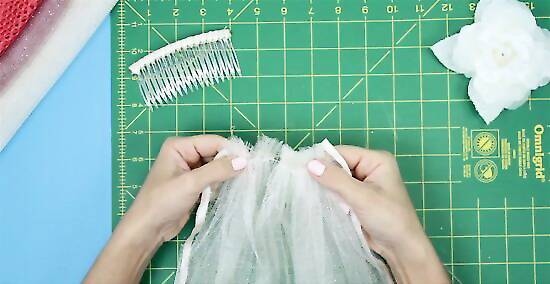
Gather your stitching, then tie the thread off. Gently tug on the end of your stitching until the tulle gathers. Keep pulling until the gathered area is the same width as your comb, about 2 to 4 inches (5.08 to 10.16 centimeters). Tie the thread off into a secure knot, then cut off the excess. If you used a sewing machine, pull on the bobbin threads.
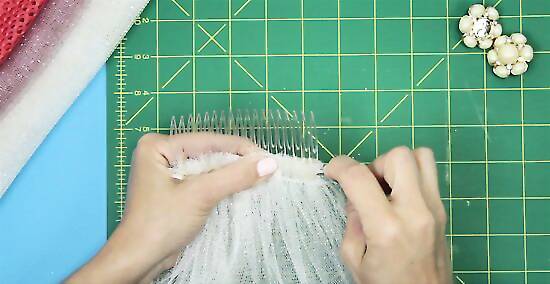
Sew the tulle to a hair comb. Match up the top edge of the veil with the top edge of the comb. Sew the veil to the comb, wrapping the thread around the comb and between the teeth. Tie the thread off in a tight knot, then snip off the excess. Some people like to wrap ribbon or extra around the comb first.
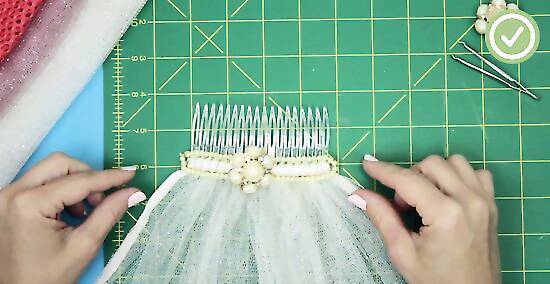
Decorate the comb, if desired. Use a needle and thread, sew on some pearls, silk flowers, beads, or rhinestones onto the comb. Be sure to choose something that matches your dress. If you must glue something on, use fabric glue. Hot glue tends to get messy, and it can melt on a hot day.
Making a Tiered Wedding Veil

Decide how long you want the veil to be. A typical veil would come down to your fingertips, but perhaps you'd prefer a floor-length veil instead. Get a helper, and have him or her measure down from the top of your head down to where you want the veil to end.
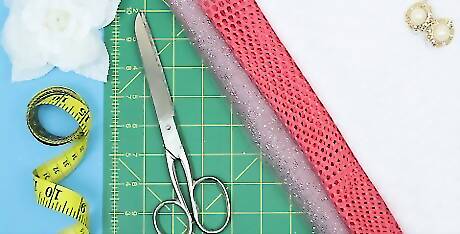
Purchase the tulle. You need to buy twice as much tulle as what you measured. This will give you enough fabric to create a second tier. Look for something that is between 72 and 108 inches (182.88 and 274.32 centimeters) wide. The wider the tulle, the fuller your veil will be.

Fold the tulle into fourths. When you purchase your tulle, it will come folded in half lengthwise. Spread the tulle down on the table or floor, with the original folded edge facing you. Grab the right narrow edge, and bring it towards the left narrow edge. Smooth the fabric down and make sure that everything is even. If the tulle is too long, you can cut it down at this point.

Round the top-left edge of the rectangle. Place something large and round, such as a serving platter, on the top-left corner of your fabric (the corner without any folds). Trace an arc using a marker, then cut it out. Make sure that the arc is going towards the bottom-right corner (the one with all the folds). This way, when you unfold the fabric, you'll get a rounded rectangle.

Unfold the tulle, then fold it in half partway. Unfold the tulle first so that you have a rounded rectangle. Bring one of the narrow edges towards the other end. This is your second tier, so how far you fold it is up to you. You can fold it all the way over to the other edge, or leave a small gap. Double-check the length again. If the veil is too long, cut it shorter, and adjust the layers as needed. Your veil may look much wider than it is long at this point. Don't worry, this is how it's supposed to be! The next few steps will fix this.
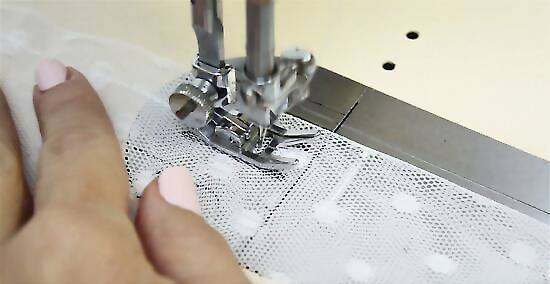
Sew across the folded, straight edge. You can sew it by hand using a running stitch, or you can sew it on a machine using a straight stitch. If you choose to sew it on a machine, sew two rows, about ½-inch (1.27-centimeter) apart. Do not knot off the end of the thread just yet. For a full veil, sew all the way across the edge. For a less-full veil, sew across the center part, leaving a gap to either side.
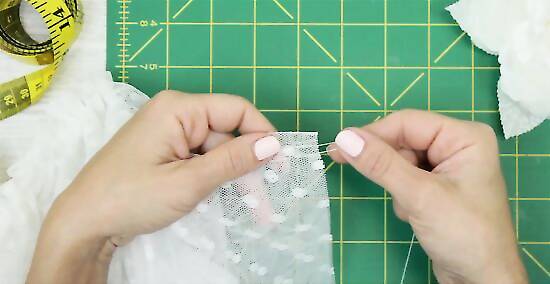
Gather your stitching, then tie the thread off. Gently tug on the end of your stitch until the tulle gathers. Keep tugging until the gathered area is the same width as your hair comb, about 2 to 4 inches (5.08 to 10.16 centimeters) wide. Tie the end of the thread off into a secure knot, then snip off the excess. If you used a sewing machine, tug on the bobbin threads.
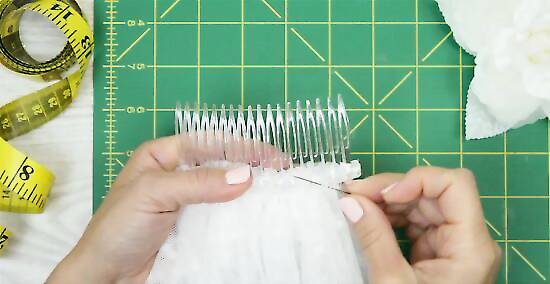
Sew the tulle to a hair comb. Align the top edge of the veil with the top edge of the comb. Sew the tulle to the comb, looping the thread around the comb and between the prongs. Tie the thread off in a tight knot when you are done, then snip off the excess. Some people like to wrap ribbon around the comb first.
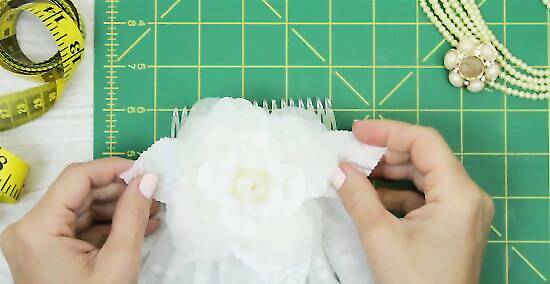
Decorate the comb, if desired. You can always tuck the comb behind a tiara on your special day, or you can decorate the comb itself. Using a needle and thread, sew on some pearls, beads, or rhinestones that match your wedding dress.
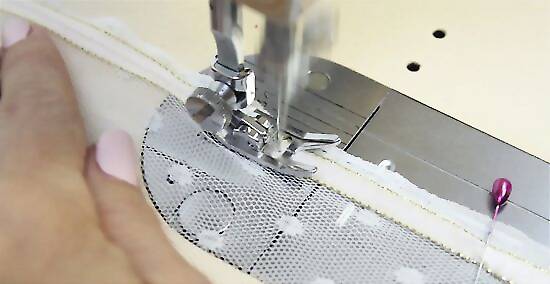
Consider adding a ribbon trim to the bottom edge of your veil. Choose some thin, satin ribbon, and pin it to the bottom tier, 1 to 2 inches (2.54 to 5.08 centimeters) away from the edge. Sew the ribbon on using the straight stitch on your sewing machine, then trim the excess tulle away. Repeat this step for the other tier. Alternatively, you can hand-sew a beaded trim instead.
Making a Birdcage Wedding Veil
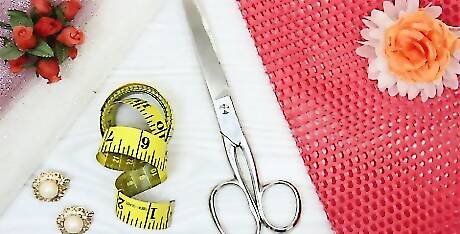
Buy some veil or millinery netting. Millinery netting is different from regular tulle in that is it stiffer with bigger, diamond-shaped openings. Popular choices include Russian and French netting. Synthetic netting will be stiffer and give you more structure. Silk netting will be softer. Choose whichever suits you best. A birdcage veil is different from the traditional, long, fluffy wedding veil. It is made from stiffer lace that goes across your face, like a birdcage. is great for vintage-themed weddings.
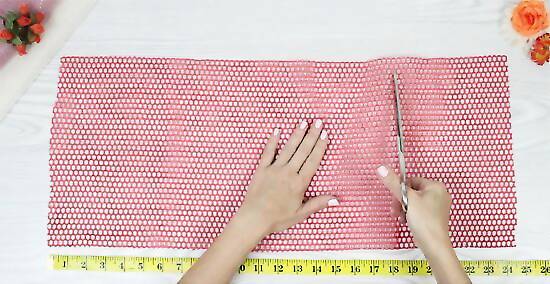
Cut the netting down to size. For a standard veil, cut the netting down to 9 inches (22.86 centimeters) high and 16 to 18 inches (40.64 to 45.72 centimeters) wide. If you want the veil to completely wrap around your head, measure the circumference of your head, add a couple of inches, and use that measurement for the width instead. You can always cut your veil longer than 9 inches (22.86 centimeters), especially if you want it to go past your chin. Try to cut straight across the connecting "dots" between the diamonds. This will give you a cleaner, neater finish.
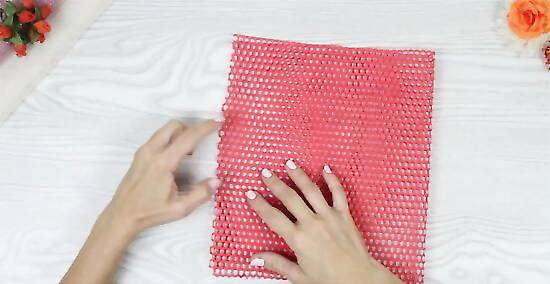
Fold the netting in half, widthwise. Lay the netting down with one of the long edges facing you. Fold the right narrow edge towards the left narrow edge, then smooth the netting flat.
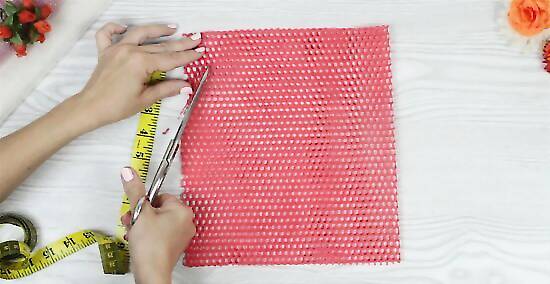
Cut the top-left corner off at an angle. When you unfold the veil, you want to end up with a trapezoid shape. How much you cut off depends how you want the veil to fall across your face. Plan on cutting off about 4 inches (10.16 centimeters) at the corner, however. Again, try to cut through the connecting dots between the diamonds.
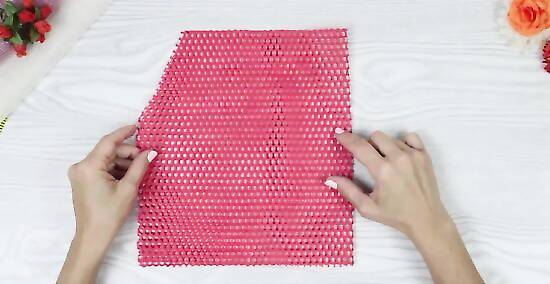
Unfold your netting, then sew across the top and angled edges. Start sewing at the bottom of the left angle, across the top straight edge, and down towards the bottom of the right angle. You will need to do this by hand, not on a sewing machine. Use clear thread or a thread color that matches your netting. Sew through the last row of diamonds. This way, you won't get a scrunchy hem.

Gather the netting, then tie the thread off. Gently tug on the thread until the gathered edge matches the length of your comb. In most cases, this will be about 2 inches (5.08 centimeters). Tie the thread off and snip off the excess. Adjust the gathers so that they fall between the knots at each end of your sewing. This will give you a neater finish.
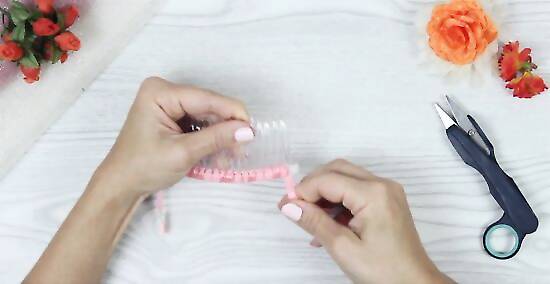
Wrap some ¼-inch (0.64-centimeter) ribbon around the top part of your comb. Choose a ribbon color that matches your netting color. Wrap it between the teeth and over the top of the comb in a spiral, from one side to the next. Secure both ends of the ribbon with hot glue (on the underside), stitching, or small knots. You can also use a ribbon color that contrasts your netting color. A black-and-white combo is both elegant and classic.
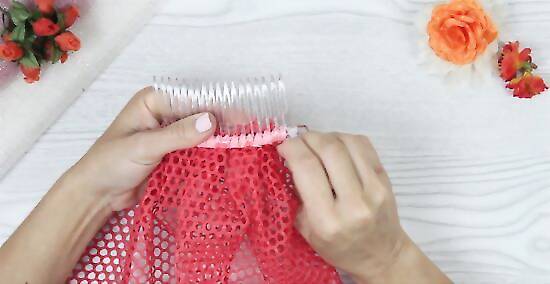
Stitch the veil to the comb. Place the top, gathered edge of your veil across the top edge of your comb. You want the gathers pointing towards the teeth, and the rest of the veil pointing away from the comb. This way, the veil drapes across your face like a birdcage (hence the name). Stitch the veil directly to the ribbon. Use clear thread or a thread color that matches the netting.
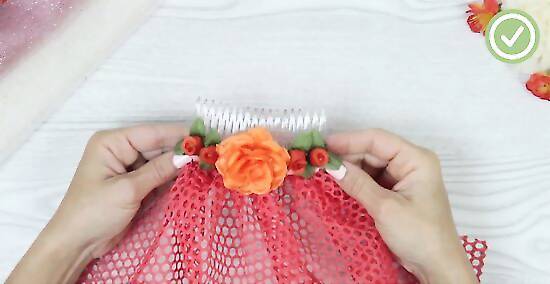
Embellish the comb, if desired. You can leave the comb as is, and choose to cover it with a chic, vintage hat. You can also embellish it with rhinestones, peals, feathers, or beads that match your beading dress. Sew the embellishments on, then snip away any excess thread.


















Comments
0 comment